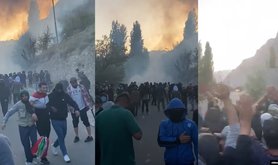Power grid
Asked what would happen if Russia theoretically blew up the four cold reactors in Enerhodar, Humeniuk says the consequences are difficult to predict – and could range from relatively mild to significant, though he stressed the latter is unlikely.
“I don’t think that they will blow up four reactors, so that only funnels will remain and it will spread [radiation] all over Ukraine. This is my point of view, it depends significantly on the force of the explosion, what will be blown up. It can be like an accident, it can be limited to the industrial site of the Zaporizhzhia plant, it can be wider."
It is worth noting that the reactors do not detonate in chain reaction, according to Oleshchuk.
Olexiy Pasiuk, deputy director of Ekodiya, an environmental protection NGO, believes the Russian army turning ZNPP into a military base poses danger in itself. Even small damage to equipment at the plant is a serious problem for Ukraine, Pasiuk says, as the country will have to manage the consequences.
With the violation of standards of physical protection of nuclear materials at the plant, and the fact that the Russian military violated all nuclear safety measures, it is difficult to predict what might happen.
According to Oleshchuk’s contacts among ZNPP workers, Ukrainian personnel are banned from certain rooms at the plant, and when they move around on the premises under Russian military escort to their posts and back, they are forbidden to look around. Oleshchuk believes we might not know everything that is happening at the plant, or what has already happened.
ZNPP does not provide energy into the Ukrainian power grid, but receives it to enable the cooling of nuclear fuel in reactors that are in “shutdown” mode. So disconnection of the ZNPP from the Ukrainian network could have consequences.
“Among options of the development of the ‘accident’, there may be a loss of connection with the Ukrainian power grid or a loss of water in the cooling pond, in which cases the removal of energy from nuclear fuel will be impossible,” Humeniuk said.
“So in this case, the water that cools the reactor will heat up to the point where it will lead to the reheating of the fuel and its partial or not melting. Then, in principle, it is possible [for], well, a certain emission of radioactive fission products, i.e. radiation, into the environment.”
Regarding the possible detonation of stored spent nuclear fuel held at ZNPP, Humenyuk rejects the risk of significant consequences, though notes it could lead to radiation pollution. “The fuel [if exploded] could dissipate across the ground, it could get into the groundwater. This is what the pollution could look like,” he said.








Comments
We encourage anyone to comment, please consult the oD commenting guidelines if you have any questions.